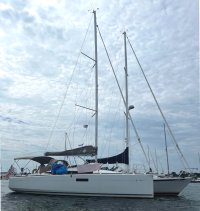Lasers are feeder boats for foiling Moths, Lasers also have Grand Master(age 55-64), Great Grand Master(age 65-74), and Legend(age 75+) classes, maybe in 20yrs Moths will too. A lot of classes have the same age divisions, just last week the yacht club my wife is the sailing director of was hosting a Grand Master team racing event in Sonars and the clubs registered were NYYC, St Francis, Southern and a couple others I forget.
There are also several foiling boats beyond the Moth like the Wazp, 69F and the whole spectrum of foiling catamarans. Also don't forget that foil kiting, wing foiling, and kiteboarding are sailing and their growth is exploding. Yes most high level foil sailors work their way up to AC and SailGP, but they started in Optis or similar. Yes most have manual control or use an auto trim stick forward of the leading foil but it's the same principal as the AC and SailGP boats with digital input/output "flight control systems" which has an operator who is a pretty accomplished sailor. The cyclist are just charging an accumulator which is pretty much the same as the "grinders" on older boats. I mean last time I checked the AC boats still have telltales on the sails... The advanced VMG calculating software and start line guidance software is available in a toned down form in cell phone sized instruments like the Vakaros Atlas 2 for dinghies. The Melges 15 class rules just changed to utilize this tech to help manage large fleets like 90+ boats at the Midwinters this year, so less people are needed for race committee. So I'd say the tech trickles down and helps the sport overall.
And with the F18 and M15 comment, I mean there has been substantial progress in materials, boat handling techniques, sail handling, and sail design since the 80's. Like they were using sym kites on catamarans in the 80's launched from deck bags, fast forward to today we use single pull snuffers with asyms. Yes granted that isn't as profound a change as foiling has been but it's progress and helps make handling high performance boats easier. I bought my Ericson 38 when I was 31yrs old in 2016 that would've been impossible if someone didn't experiment with making cheap fiberglass boats decades before I was born.
Hundreds of cruising cats in the Caribbean? Cool that means in 20yrs there will be hundreds of cheaper used cruising cats available to purchase when I retire and have time to cruise.







